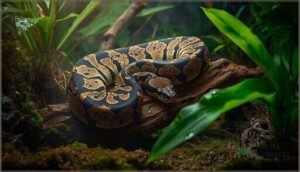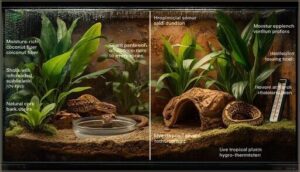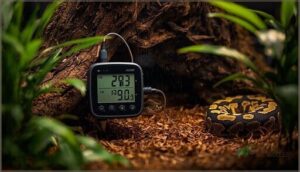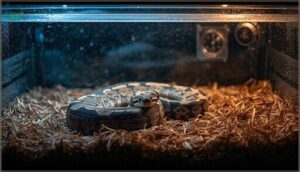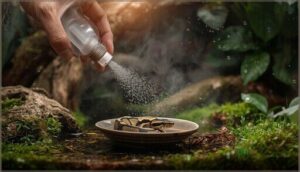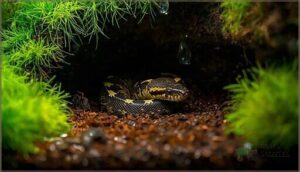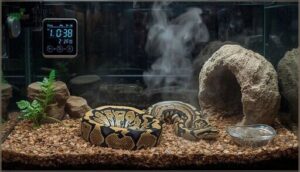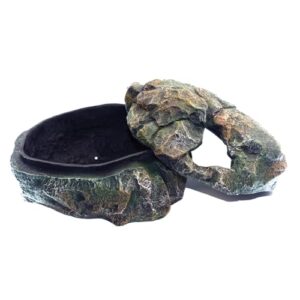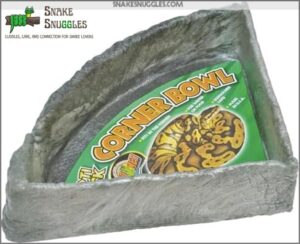This site is supported by our readers. We may earn a commission, at no cost to you, if you purchase through links.
Your ball python’s humidity gauge reads 45%, and you notice patches of stuck shed clinging to its scales. This scenario plays out in countless enclosures because maintaining ideal humidity levels for ball pythons sits at the heart of successful captive care.
These West African natives evolved in environments where humidity hovers between 55% and 70%, and their bodies depend on that moisture range for everything from proper hydration to clean sheds.
When humidity strays outside this window, your snake faces real consequences—respiratory infections from excessive moisture, dehydration from too little, or the painful condition of scale rot. Getting the balance right requires understanding both the target numbers and the practical methods to achieve them consistently.
Table Of Contents
- Key Takeaways
- Ideal Humidity Levels for Ball Pythons
- Why Proper Humidity is Crucial
- Effects of Incorrect Humidity Levels
- Factors That Influence Humidity in Enclosures
- Tips to Maintain Optimal Humidity
- Top Products for Ball Python Humidity Control
- Frequently Asked Questions (FAQs)
- How much humidity does a ball python need?
- How to keep a ball python healthy?
- How do you care for a ball python?
- How do you increase humidity in a ball python?
- Does misting a ball python increase humidity?
- What temperature should a ball python hide be?
- Is 80% humidity too high for ball pythons?
- Is 50% humidity good for a ball python?
- Can you leave a heat lamp on 24/7 for ball python?
- What should the humidity be in a ball python tub?
- Conclusion
Key Takeaways
- Ball pythons require consistent humidity between 55-70% to prevent serious health complications including respiratory infections, dehydration, and scale rot, with temporary increases to 75-80% during shedding cycles to ensure clean skin removal.
- Improper humidity levels directly impact lifespan—maintaining the ideal range can add up to 10 years to your snake’s life, while levels below 50% or above 85% create life-threatening conditions through compromised immune function and bacterial growth.
- Effective humidity control depends on three foundational elements: moisture-retaining substrates like coconut husk or cypress mulch, strategic water dish placement near heat sources for controlled evaporation, and PVC enclosures that prevent rapid moisture loss better than glass tanks with screen tops.
- Daily hygrometer monitoring at substrate level is non-negotiable for successful ball python care, as even brief humidity fluctuations outside the target range trigger stress responses and health issues that compound over time.
Ideal Humidity Levels for Ball Pythons
Getting humidity right is one of the most critical aspects of ball python care. Your snake needs a consistent environment that mirrors the tropical grasslands of West Africa, where temperatures and moisture levels stay relatively stable year-round.
Let’s break down the specific humidity ranges your ball python needs to thrive.
Recommended Humidity Range (55-70%)
Your ball python thrives when humidity levels stay between 55% and 70%, mirroring the conditions of its native African habitat. This range promotes healthy skin, proper hydration, and reliable shed cycles—all critical markers of snake health.
Key humidity control practices include:
- Placing a digital hygrometer at habitat level for accurate readings
- Using water-retaining substrates like cypress mulch or coconut husk
- Positioning water dishes in cooler zones to boost ambient moisture
- Adjusting ventilation management to prevent excessive dryness
- Adding a humid hide lined with damp moss for localized humidity
Regular monitoring with your hygrometer keeps humidity levels stable, preventing the stress and health complications that come from fluctuating conditions. Even brief dips below 55% can impact ball python care outcomes, so daily checks matter. Understanding the importance of proper snake habitats is vital for maintaining ideal environments.
Temporary Increases During Shedding (Up to 80%)
When your ball python enters its shed cycle, you’ll want to raise humidity temporarily to 75-80%. This temporary increase aids skin hydration and prevents incomplete sheds that plague drier enclosures.
Boost moisture through more frequent misting, adding damp sphagnum moss to humid hides, or increasing water dish size. Monitor your hygrometer daily during this phase to verify humidity spikes don’t exceed safe thresholds while maintaining proper humidity control.
Proper reptile shed care is essential for preventing shedding problems.
Mimicking Natural Habitat Conditions
Your ball python’s native West African habitat provides a blueprint for humidity control. Daytime levels hover between 60-80%, while nighttime burrow replication creates microclimate control approaching 90%.
These humidity gradients support natural environmental cycles and temperature gradient regulation.
You’ll achieve effective reptile humidity management by incorporating damp hides that simulate burrows, allowing your ball python to self-regulate moisture exposure just as it would in savanna grasslands.
Relative Humidity and Measurement
Understanding relative humidity means knowing how temperature affects moisture readings. Your digital hygrometer measures water vapor relative to air temperature—when temps rise just 1°C, humidity drops roughly 3%. That’s why accurate measurement tools matter:
- Capacitive sensors adjust readings independent of atmospheric pressure
- Entry-level hygrometers carry ±5% accuracy margins
- Calibration methods using salt tests improve reliability
- Dual temperature-humidity monitoring prevents misreadings
Position your hygrometer at substrate level where your snake lives for meaningful environmental monitoring.
Why Proper Humidity is Crucial
Humidity isn’t just a number on a gauge—it’s the difference between a healthy ball python and one struggling with preventable health problems. When humidity levels fall outside the ideal range, your snake faces real risks that can affect everything from routine shedding to long-term survival.
Understanding why proper humidity matters will help you recognize warning signs early and keep your ball python thriving for years to come.
Impact on Shedding and Skin Health
Your snake’s shedding process depends entirely on proper humidity levels between 50-80%. When humidity drops below 50%, you’ll see retained shed around eyes and tail—potentially constricting blood flow. Low humidity also causes wrinkled, dehydrated skin.
Conversely, excessive humidity beyond 80% creates conditions for scale rot and skin infections. Maintaining a humidity gradient with humid hides ensures successful shed cycle management while preventing shedding disorders that compromise scale health.
Prevention of Respiratory Infections
Consistently maintaining humidity between 50-60% protects your ball python’s respiratory health by keeping mucous membranes moist and functional. When humidity drops below 55%, respiratory secretions thicken and accumulate—creating pathways for bacterial and fungal infections.
Hygrometer accuracy matters here, as does proper ventilation to prevent stagnant air. Environmental management through humidity control directly strengthens your snake’s immune defense against respiratory infection.
Risks of Dehydration and Scale Rot
Improper humidity control threatens your ball python through two dangerous extremes. Below 50%, dehydration draws moisture from your snake’s body through osmosis—producing dull scales, retained shed, and lethargy. Above 80% with damp substrate, bacterial growth flourishes, causing scale rot with blisters and open wounds. Your hygrometer becomes essential for preventing these skin infections through precise reptile hygiene and consistent monitoring.
- Sharp ridges appearing along dehydrated skin
- Discolored scales signaling early bacterial infection
- Silver eye haze indicating severe water loss
- Foul odor from progressing scale rot lesions
Effects on Ball Python Longevity
Your ball python’s lifespan hinges on humidity control—proper levels can add up to 10 years. Maintaining 55-70% humidity protects respiratory health and prevents shedding issues that trigger infections. Below 50%, mortality rates climb through dehydration and compromised immune function. Above 85%, scale rot and bacterial growth threaten snake health and wellness, making your hygrometer essential for managing humidity stress and longevity factors.
Proper humidity control between 55-70% can extend your ball python’s lifespan by up to 10 years
| Humidity Level | Health Impact | Lifespan Effect |
|---|---|---|
| Below 50% | Respiratory infections, dehydration | Reduced longevity |
| 55-70% (Ideal) | Healthy shedding, strong immunity | Maximum lifespan |
| 70-80% (Shedding) | Clean sheds, skin renewal | Aids longevity |
| Above 85% | Scale rot, bacterial growth | Shortened lifespan |
| Fluctuating | Chronic stress, feeding issues | Decreased longevity |
Effects of Incorrect Humidity Levels
Getting the humidity wrong can seriously harm your ball python’s health. Both too little and too much moisture create distinct problems that you need to recognize quickly.
Let’s look at what happens when humidity levels fall outside that safe zone and how to spot the warning signs before they become serious issues.
Health Problems From Low Humidity
Your ball python’s respiratory system relies on adequate moisture to function properly. When humidity drops below 60%, you’ll notice respiratory issues like wheezing and nasal discharge.
Shedding problems become common as dry skin refuses to peel away cleanly. Dehydration risks escalate quickly, while cracked skin invites skin infections.
Humidity monitoring isn’t optional—it’s essential for snake health and wellness through proper humidity control.
Dangers of High Humidity
High humidity above 70% creates a breeding ground for bacterial infections and fungal growth in your snake’s enclosure. Scale rot risks increase dramatically when moisture combines with poor ventilation—you’ll see discolored belly scales and lesions.
Humidity fluctuations stress your python’s immune system, while waterlogged substrates complicate shedding and skin health. Maintaining humidity control between 55-70% prevents these serious complications.
Recognizing Signs of Humidity Imbalance
When humidity levels drift outside the ideal range, your ball python’s body will tell you something’s wrong. Watch for these physical indicators:
- Stuck shed patches clinging to skin signal insufficient moisture—a clear shedding problem requiring immediate humidity control adjustments.
- Sunken or cloudy eyes reveal dehydration signs from prolonged exposure to dry conditions.
- Respiratory issues like wheezing or mouth discharge indicate humidity stress affecting your snake’s breathing.
- Skin lesions or flaky scales point to humidity management failures damaging skin integrity.
Factors That Influence Humidity in Enclosures
Your enclosure setup plays a bigger role in humidity control than you might think. Everything from the material you choose to how much air flows through affects whether your ball python stays in that ideal 55-70% range.
Let’s break down the main factors you can actually adjust to keep humidity stable.
Substrate Choices and Their Impact
Your choice of substrate directly affects how well your ball python’s enclosure holds moisture. Coconut husk and cypress mulch retain humidity effectively for days, supporting healthy shedding and consistent humidity levels between 60-80%. Aspen dries quickly and requires weekly replacement.
Bioactive substrates with soil blends mimic natural conditions while gradually releasing moisture. Pour water into the substrate every 4-5 days rather than frequent misting for better humidity control.
Cage Material and Ventilation
PVC enclosures are your best option for maintaining stable humidity levels between 60-90%, thanks to their moisture-resistant properties. Glass tanks with screen lids lose humidity rapidly, often dropping below 50%.
You can fine-tune airflow management in plastic tubs by covering some ventilation holes with tape. Too much ventilation dries out your enclosure, while too little creates stagnant air that risks respiratory infections.
Room Humidity and Environmental Changes
Beyond your enclosure setup, ambient room humidity and environmental factors directly shape conditions inside your ball python’s home. Consider these climate control realities:
- Rooms below 40% humidity require daily intervention to keep enclosure levels near 55-70%
- Winter heating systems can drop humidity by 10-35% in 24 hours
- Air conditioning reduces moisture, demanding supplementary misting
- Seasonal temperature gradient shifts alter humidity by 10-20% without adjustments
Monitor both spaces with hygrometers for effective humidity management and stable air circulation.
Water Dish Placement and Size
Your water bowl does more than hydrate—it’s a humidity engine. A wide dish placed near your heat source boosts evaporation rates by 10%, while material choices like ceramic retain stable microclimates better than plastic. Bowl placement creates humidity gradients across your enclosure, requiring strategic positioning for balanced moisture distribution.
Monitor with hygrometers to document gradients and adjust bowl positioning for ideal ball python care without excessive misting.
| Factor | Impact on Humidity | Best Practice |
|---|---|---|
| Bowl Placement | Near heat: +10% local humidity | Position on warm side for controlled evaporation |
| Water Bowl Depth | 2-4 inches ideal for soaking | Shallow, wide design maximizes surface area |
| Dish Material | Ceramic holds temperature better | Use non-porous materials; clean weekly |
| Bowl Size | Large dishes raise humidity 15% | Minimum 6-8 inches diameter for adults |
| Refill Frequency | Evaporation reduces volume 20-30% | Replace water every 2-3 days in heated enclosures |
Tips to Maintain Optimal Humidity
Maintaining the right humidity level doesn’t have to be complicated once you understand a few key strategies. The tools and techniques you use will directly affect how stable your enclosure conditions remain throughout the day.
Here’s what you need to focus on to keep your ball python’s environment consistently within that 55-70% range.
Using Hygrometers for Monitoring
You can’t manage what you don’t measure—and accurate hygrometer readings are your first line of defense. Digital sensors designed for reptile enclosures usually maintain precision within ±3% relative humidity, but calibration methods like the salt test verify your device stays reliable.
Place your hygrometer at substrate level where your ball python actually lives, and check it daily to catch dangerous fluctuations before they affect your snake’s health.
Adjusting Ventilation and Substrate
For ideal humidity retention, you’ll need to balance airflow management with substrate moisture. Covering about three-quarters of mesh enclosure tops with plastic can dramatically reduce humidity loss by up to 40%, while moisture-retaining substrates like coconut husk maintain 60-80% humidity for five days.
Strategic ventilation placement—lower vents on the cool side, higher on the warm side—facilitates a proper temperature gradient while preventing excessive drying.
Misting and Water Dish Strategies
You’ll control humidity levels most effectively by pairing a shallow water bowl with strategic misting timing.
Large water dishes increase evaporation rates steadily, contributing 5-10% humidity daily, while misting 1-2 times weekly provides humidity spikes when needed.
During shedding, boost your misting system frequency to reach 70-80%. Avoid over-misting—it creates bacterial growth and respiratory risks without sustained humidity management benefits.
Employing Humid Hides and Moist Substrate
Think of humid hides as moisture sanctuaries—your ball python’s personal spa retreat during shedding cycles. Line yours with damp sphagnum moss to create localized humidity spikes reaching 80-100%, while moist substrate types like coconut fiber establish a stable humidity gradient throughout the enclosure.
This microclimate creation lets your snake self-regulate, accessing higher moisture zones without constant misting intervention.
Top Products for Ball Python Humidity Control
Maintaining the right humidity for your ball python becomes much easier with the right tools. A reliable hygrometer, a quality hide, and a well-designed water dish form the foundation of effective humidity control.
Here are three essential products that will help you create and maintain ideal conditions in your enclosure.
1. Digital Reptile Hygrometer Sensor Meter
Accurate humidity monitoring starts with a reliable digital hygrometer designed for reptile enclosures. You’ll want a model with ±3% meter precision and a clear digital display showing both temperature and humidity levels.
Proper sensor placement matters—position the probe at your ball python’s level inside the enclosure, not on the glass or lid where readings skew.
Most units arrive factory-calibrated, though periodic humidity calibration against a known standard ensures ongoing accuracy. Features like min/max memory help you track ventilation effectiveness and environmental fluctuations throughout the day.
2. Zoo Med Reptile Cave Hide
The Zoo Med Repti Shelter 3-in-1 Cave transforms humidity management into a behavioral tool your ball python will actually use. Available in Large (6″ x 12″ x 11″), this ceramic hideout creates humid microclimates that boost local moisture by 10-20% above ambient levels when filled with dampened sphagnum moss or Eco Earth.
The removable lid simplifies hide maintenance during your reptile enclosure setup, while the porous ceramic material retains moisture longer than plastic alternatives.
Position it on the warm side of your temperature and humidity management gradient—your snake will seek this humidity hide naturally during shedding cycles.
3. Reptile Corner Water Dish Large
While hides manage localized humidity spikes, your water bowl placement determines baseline moisture throughout the reptile enclosure.
The Reptile Corner Water Dish Large (16 cm x 18 cm x 5.5 cm) maximizes surface area for evaporation without wasting floor space—position it near your warm zone to boost ambient humidity levels by 5-10%.
This corner dish benefits your setup with daily reptile hydration opportunities and natural soaking behavior during sheds. Replace water daily and monitor how misting frequency changes once this larger bowl stabilizes your humidity control system.
Frequently Asked Questions (FAQs)
How much humidity does a ball python need?
Ball pythons aren’t desert dwellers, despite what neglectful care sheets suggest.
Your snake needs 55-70% humidity levels consistently, mimicking their West African origins, ensuring proper hydration needs and ideal snake health through careful environmental control.
How to keep a ball python healthy?
Keep your Ball Python healthy by maintaining proper humidity levels between 55-70% and ensuring accurate Temperature Management.
Provide quality Snake Nutrition, conduct regular Health Checks, and optimize ventilation.
Support successful shedding through Environmental Enrichment and diligent Reptile Care practices.
How do you care for a ball python?
Want to guarantee your ball python thrives? Proper reptile care involves maintaining temperature control at 88-92°F, humidity levels between 55-70%, a secure snake enclosure, consistent python handling tips, regular reptile health checks, and balanced ball python nutrition.
How do you increase humidity in a ball python?
You can increase humidity by placing a large water dish on the warm side, misting daily with dechlorinated water, adding a humid hide with moist sphagnum moss, and reducing ventilation gaps.
Does misting a ball python increase humidity?
Yes, misting temporarily raises humidity levels in your ball python’s enclosure, though the effect is short-lived. Ventilation and substrate type determine how quickly moisture dissipates, making it a supplemental rather than primary humidity control method.
What temperature should a ball python hide be?
Your ball python’s warm hide should maintain an internal temperature between 88°F and 92°F, with 90°F being ideal. This range promotes proper digestion and thermoregulation without risking thermal stress or burns.
Is 80% humidity too high for ball pythons?
Sustained 80% humidity creates a breeding ground for bacterial growth and scale rot without proper ventilation. During shedding, temporary spikes to this level help your ball python, but constant exposure invites respiratory complications and skin infections.
Is 50% humidity good for a ball python?
Fifty percent sits at the acceptable minimum, but you’ll need to supplement it with humid hides and proper ventilation.
Without localized moisture zones, your ball python risks dehydration and incomplete shedding cycles.
Can you leave a heat lamp on 24/7 for ball python?
Set it and forget it doesn’t apply regarding heat lamp safety. You can run ceramic emitters continuously with thermostat settings, but light-producing heat sources disrupt natural cycles and increase burn risks without proper controls.
What should the humidity be in a ball python tub?
You should maintain humidity between 55% and 70% in your ball python tub for ideal reptile health.
During shedding periods, increase humidity levels to 70-80% while ensuring proper ventilation and snake habitat conditions.
Conclusion
Don’t let your humidity game fall flat—your ball python’s health depends on getting the moisture balance right. Maintaining ideal humidity levels for ball pythons between 55% and 70% isn’t complicated once you establish reliable monitoring systems and adjust your setup based on actual readings.
Check your hygrometer daily, modify substrate moisture as needed, and provide that essential humid hide. Your snake’s clean sheds and vibrant health will prove you’ve mastered this essential aspect of reptile care.
- https://www.thebiodude.com/blogs/snake-caresheets/ball-python-care-guide
- https://www.hvreptilerescue.org/resources/care-guides/ball-python-care-guide
- https://reptifiles.com/ball-python-care-guide/ball-python-humidity-temperatures/
- https://www.petmd.com/reptile/ball-python-care-sheet
- https://inkbird.com/blogs/aquarium-terrarium/ball-python-enclosure-ideas-size-humidity-temperature



